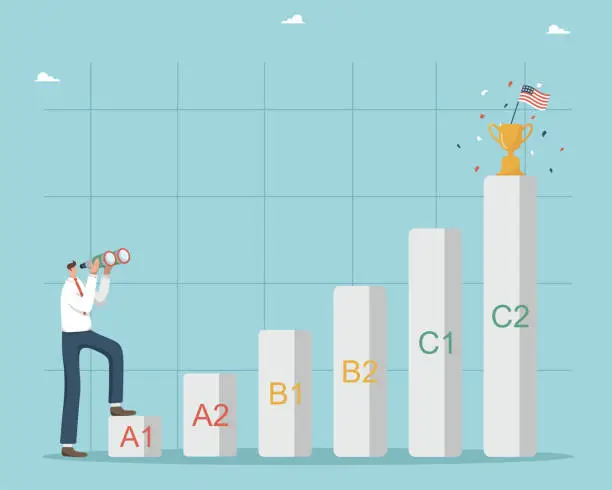Learning a language does not happen overnight, especially a global language like English. Whether you’re a beginner or already fluent, understanding the English language levels from A1 to C2 is the foundation for properly tracking your progress, setting goals, and following the right course materials. These are levels that indicate your proficiency in using English in professional or academic environments; the levels are useful for clarifying what kinds of jobs and institutions require your level of English.
In this blog, we’ll take you step by step through each English language learner’s level—from level A1 to C2—explaining the differences, guiding you on how to determine your level, and how to improve.
What Are English Language Levels?
The CEFR organises language proficiency in six levels, A1 to C2, which can be regrouped into three broad levels (Basic User, Independent User, and Proficient User) that are further subdivided according to the needs of the local context. The system is implemented at a global level to assess the language abilities of English learners in spoken, listening, reading, and writing skills. For what it’s worth, each level does match up with certain skills:
- A1–A2: Basic User
- B1–B2: Independent User
- C1–C2: Proficient User
Whether you’re preparing for language exams, learning English in school, or simply optimizing your language skills, knowing your English language learners‘ levels helps you plan your work realistically and “hit the yardstick” the way learners should!

A1: Beginner – Survival English
The English language A1 is the lowest level. Learners at this level comprehend and use simple expressions and common, day-to-day phrases–all of which are familiar to them–to meet concrete needs.
What You Can Do at A1:
- Introduce yourself and others.
- Ask and respond to questions about personal information (names, age, place of residence).
- Communicate straightforwardly if the other person speaks slowly and clearly.
At level A1, learners are at the beginning of their learning journey. This is the level commonly taught in EFL (English as a foreign language) and ELA (English language arts) curricula.
A2: Elementary – Social English
Above the English language level A1, A2 students can comprehend sentences and commonly used expressions about very popular topics, common in everyday experience or at work, and basic directions.
What You Can Do at A2:
- Handle fundamental and simple routine types of tasks, which may require a short direct exchange of information.
- Learn phrases and vocabulary that are used in everyday life.
- Summarize something about them in plain language.
A2 represents the transition from simple words to conversations, communicating a basic understanding of complex topics. For the majority of learners, progressing through A2 is essential to cope with basic social situations.
B1: Intermediate – Functional English
At this level, learners become intermediate-level. It’s here where your fluency levels in English begin to form.
What You Can Do at B1:
- Able to understand the main points of clear standard input on familiar matters.
- Handle the majority of what will come up while you’re traveling.
- Write clear, connected text on familiar topics.
- Talk about stories, dreams, hopes, and aspirations.
B1 is also sufficient for job applications in English-speaking companies. At this level, English language learners progress from learners to independent communicators.
B2: Upper Intermediate – Confident User
Learners at the B2 level are increasingly independent and comfortable communicating in a range of contexts.
What You Can Do at B2:
- Understand the main ideas of complex texts, including technical discussions.
- Interact fluently and spontaneously without much strain.
- Produce detailed text on a wide range of subjects.
- Explain viewpoints, giving advantages and disadvantages.
B2 is one of the most practical English language levels for academic and professional purposes. Many universities require this level for admission, and most workplace environments expect this proficiency.
C1: Advanced – Fluent and Flexible
Reaching C1 is a high level of fluency. Indeed, learners are now proficient users who can communicate effectively and appropriately on a range of topics.
What You Can Do at C1:
- Comprehend long, complex texts, literary or technical.
- Grammarly-grab for social, professional, and academic applications of your words.
- Flow of thoughts without groping for words.
- Construct well-structured, detailed arguments.
That is where English fluency levels indicate much more than mere ability, but also control and confidence. C1 users are very close to native speakers in many ways.
C2: Proficiency – Mastery of the Language
C2 is the highest level in English on the CEFR scale, indicating a proficiency level ranging from very advanced to native. Learners at this stage can understand almost everything that they read or hear.
What You Can Do at C2:
- Paraphrase information from a variety of spoken and written sources.
- Respond immediately and accurately, and communicate spontaneously and fluently.
- Take on the toughest college and post-graduate work with ease.
Achieving C2 demonstrates mastery. Not many students get here, but it’s the highest level for English language learners.
English Language Levels and Exams
Understanding English language levels helps you choose the right certification exam or course to suit your needs. Here’s how CEFR levels align with common exams:
CEFR Level | IELTS | TOEFL iBT | Cambridge Exam |
A1 | Below 4.0 | < 31 | Key (KET) |
A2 | 4.0–4.5 | 32–34 | Key (KET) |
B1 | 4.5–5.5 | 35–45 | Preliminary (PET) |
B2 | 5.5–6.5 | 46–93 | First (FCE) |
C1 | 7.0–8.0 | 94–110 | Advanced (CAE) |
C2 | 8.5–9.0 | 111–120 | Proficiency (CPE) |
These benchmarks support learners in setting academic or immigration goals, making understanding English language fluency levels vital for long-term planning.
How to Move from One Level to the Next

To progress through the English language learners’ levels, here are real-world recommendations:
- Daily Practice: Language is a daily thing. Read, write, say, listen every day.
- Utilize Graded Materials: Opt for books, podcasts, and movies that are created for your level.
- Practice Speaking: Speaking practice is the fastest way to fluency.
- Enroll in a Course or Program: Achieve faster results with a structured program.
- Keep track of your progress: Use the CEFR checklists and download language apps to check your progress.
You can progress independently from English language level A1 to the highest English language fluency levels using these techniques.
Why Knowing Your Level Matters
It’s essential to know where you are so you can:
- Setting realistic learning goals.
- Choosing suitable study materials.
- Preparing for international exams.
- Working or studying abroad.
Every step of the way in the CEFR scale contributes significantly to your linguistic progress. When it comes to accounting for English language levels, you can personalize the learning experience for optimal outcomes.
Final Thoughts
From levels A1 to C2 of the Common European Framework of Reference, it’s learning that makes all the difference. Whether you’re just starting or aiming to achieve greatness, these English language learners’ levels provide a clear path.
If you grasp the CEFR, you’ll be able to assess your strengths and weaknesses, and also celebrate your progress after reaching each milestone. Very friendly. Keep it up. With persistence and the correct resources, you can progress through all the English language fluency levels.
Ready to Improve Your English Language Level?
Here at Language Learning, we are dedicated to following you along for every stage of your English course, from English proficiency levels A1 to C2. Our professional tutors tailor all English language classes online to help you learn at your own pace to achieve your learning goals by mastering each of the English language learners’ levels.
Whether you need to learn conversational English for a new job or get ready for a trip to an English-speaking country, Language Learnings has you covered. With trial lessons as low as $3.50, you can discover how good you are (or not) in your keyboarding, set targets for what you’d like to achieve, and proceed to fluency from a position of strength.
Take the next step toward getting a grip on English — try out the Language Learnings!






